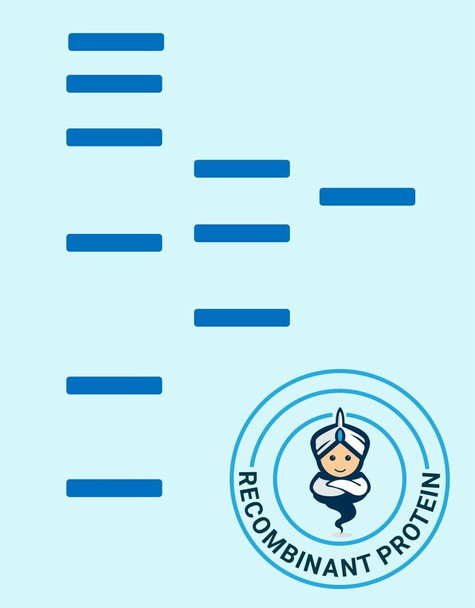Human STAR Recombinant Protein (RPPB4841)
- SKU:
- RPPB4841
- Product Type:
- Recombinant Protein
- Species:
- Human
- Uniprot:
- P49675
Description
| Product Name: | Human STAR Recombinant Protein |
| Product Code: | RPPB4841 |
| Size: | 20µg |
| Species: | Human |
| Target: | STAR |
| Synonyms: | Steroidogenic acute regulatory protein, STARD1, StAR, START domain-containing protein 1, cholesterol trafficker, Mitochondrial steroid acute regulatory protein, StAR-related lipid transfer (START) domain containing 1. |
| Source: | Escherichia Coli |
| Physical Appearance: | Sterile Filtered colorless solution. |
| Formulation: | The STAR solution (1mg/1ml) contains 20mM Tris-HCl buffer (pH 8.0), 2mM DTT and 20% glycerol. |
| Stability: | Store at 4°C if entire vial will be used within 2-4 weeks. Store, frozen at -20°C for longer periods of time. For long term storage it is recommended to add a carrier protein (0.1% HSA or BSA).Avoid multiple freeze-thaw cycles. |
| Purity: | Greater than 90% as determined by SDS-PAGE. |
| Amino Acid Sequence: | MGSSHHHHHH SSGLVPRGSH MEETLYSDQE LAYLQQGEEA MQKALGILSN QEGWKKESQQ DNGDKVMSKV VPDVGKVFRL EVVVDQPMER LYEELVERME AMGEWNPNVK EIKVLQKIGK DTFITHELAA EAAGNLVGPR DFVSVRCAKR RGSTCVLAGM ATDFGNMPEQ KGVIRAEHGP TCMVLHPLAG SPSKTKLTWL LSIDLKGWLP KSIINQVLSQ TQVDFANHLR KRLESHPASE ARC |
STAR facilitates the fast increase in pregnenolone synthesis stimulated by tropic hormones. STAR increases pregnenolone synthesis more than four-fold and a major STAR transcription of 1.6 kb is observed in ovary and testis. Throughout the growth and differentiation period of the ovary follicle, the immunoreactivity is likely to move from the granulosa cells of early antral follicles to the theca cell layers in the adult.
STAR Human Recombinant produced in E.coli is a single, non-glycosylated polypeptide chain containing 243 amino acids (64-285) and having a molecular mass of 27.1 kDa.STAR is fused to a 21 amino acid His-tag at N-terminus & purified by proprietary chromatographic techniques.
| UniProt Protein Function: | STAR: Plays a key role in steroid hormone synthesis by enhancing the metabolism of cholesterol into pregnenolone. Mediates the transfer of cholesterol from the outer mitochondrial membrane to the inner mitochondrial membrane where it is cleaved to pregnenolone. May interact with TSPO. Expressed in gonads, adrenal cortex and kidney. |
| UniProt Protein Details: | Protein type:Mitochondrial; Lipid-binding; Carrier Chromosomal Location of Human Ortholog: 8p11.2 Cellular Component: mitochondrial crista; neuron projection; cell soma; mitochondrial intermembrane space; cytosol Molecular Function:cholesterol transporter activity; cholesterol binding Biological Process: response to nicotine; steroid metabolic process; diterpenoid metabolic process; dibenzo-p-dioxin metabolic process; regulation of steroid biosynthetic process; estrogen biosynthetic process; biphenyl metabolic process; circadian sleep/wake cycle, REM sleep; negative regulation of neuron apoptosis; response to nutrient; response to corticosterone stimulus; response to drug; cholesterol metabolic process; bile acid biosynthetic process; positive regulation of neurogenesis; insecticide metabolic process; progesterone biosynthetic process; fractalkine metabolic process; male gonad development; phthalate metabolic process; intracellular cholesterol transport; response to herbicide; glucocorticoid metabolic process; response to ethanol; response to hydrogen peroxide; cellular response to insulin stimulus; response to estrogen stimulus; response to lead ion; C21-steroid hormone biosynthetic process; brain development; response to activity; response to ionizing radiation; steroid biosynthetic process; regulation of neuronal synaptic plasticity; phenol metabolic process Disease: Lipoid Congenital Adrenal Hyperplasia |
| NCBI Summary: | The protein encoded by this gene plays a key role in the acute regulation of steroid hormone synthesis by enhancing the conversion of cholesterol into pregnenolone. This protein permits the cleavage of cholesterol into pregnenolone by mediating the transport of cholesterol from the outer mitochondrial membrane to the inner mitochondrial membrane. Mutations in this gene are a cause of congenital lipoid adrenal hyperplasia (CLAH), also called lipoid CAH. A pseudogene of this gene is located on chromosome 13. [provided by RefSeq, Jul 2008] |
| UniProt Code: | P49675 |
| NCBI GenInfo Identifier: | 71152974 |
| NCBI Gene ID: | 6770 |
| NCBI Accession: | P49675.2 |
| UniProt Secondary Accession: | P49675,Q16396, |
| UniProt Related Accession: | P49675 |
| Molecular Weight: | 285 |
| NCBI Full Name: | Steroidogenic acute regulatory protein, mitochondrial |
| NCBI Synonym Full Names: | steroidogenic acute regulatory protein |
| NCBI Official Symbol: | STAR�� |
| NCBI Official Synonym Symbols: | STARD1�� |
| NCBI Protein Information: | steroidogenic acute regulatory protein, mitochondrial; cholesterol trafficker; START domain containing 1; steroid acute regulatory protein; START domain-containing protein 1; mitochondrial steroid acute regulatory protein; StAR-related lipid transfer (START) domain containing 1 |
| UniProt Protein Name: | Steroidogenic acute regulatory protein, mitochondrial |
| UniProt Synonym Protein Names: | START domain-containing protein 1; StARD1 |
| Protein Family: | Starch synthase |
| UniProt Gene Name: | STAR�� |
| UniProt Entry Name: | STAR_HUMAN |










